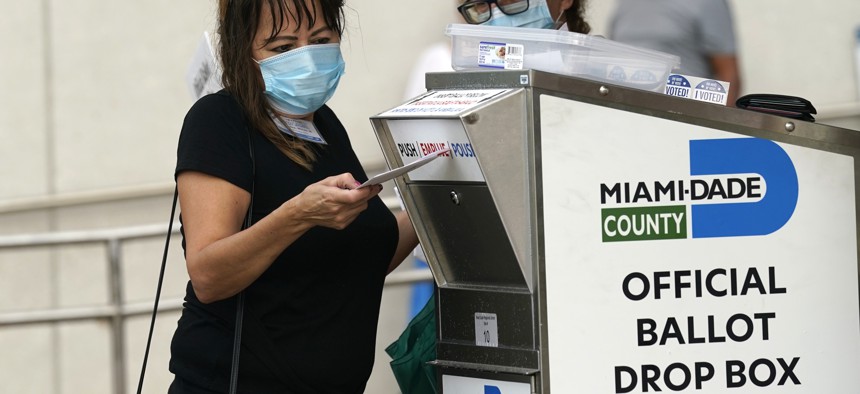With Early Voting Crowds Come Long Lines, Last Minute Changes

An election worker places a vote-by-mail ballot into an official ballot drop box outside of an early voting site, Monday, Oct. 19, 2020, in Miami. AP Photo/Lynne Sladky

Connecting state and local government leaders
More than 28 million people have already cast ballots for the presidential election as many states have changed absentee voting protocol to make it easier to vote early.
The record number of ballots cast early in this year’s presidential election has brought new complications for election officials, who have had to address long lines, last-minute court decisions, and technical glitches.
As of Monday morning, 28 million people had cast ballots in the presidential election, or the equivalent of 20% of the total votes cast altogether in the 2016 election, according to the U.S. Election Project. About 81 million people have requested mail-in ballots.
The pace of early voting is expected to pick up this week, as more states open in-person polling places and absentee ballots are returned, said Michael McDonald, a professor at the University of Florida who runs the U.S. Election Project websites.
Early voting kicked off Monday in Florida, where voters lined up hours before the polls even opened in anticipation of heavy turnout.
Local officials said long lines are common on the first day or in-person voting in Florida. But Sarasota County Supervisor of Elections Ron Turner told the Sarasota Herald-Tribune that "it's been a long time" since lines outside the county election office stretched as long as they did Monday morning.
Long lines on the first day of early voting were a common occurrence at polling places in other states including Texas, Georgia and Virginia.
But local election officials also expressed hope the early surge would reduce crowding and long lines on Nov. 3.
In Fulton County, Georgia, officials hope to drive 80% of voters to cast ballots before Election Day either through early in-person voting or absentee voting, said Richard Barron, director of the county’s Board of Elections and Registration.
In some states where early voting has been available, numbers may level off this week, but will likely pick up in the week ahead of the election, McDonald said.
“The pace typically picks up again the last week prior to the election, particularly as younger voters get into the mix,” McDonald wrote on his blog.
In addition to long lines, election officials’ have been overwhelmed by queries from residents about the procedures for this year.
Pennsylvania has rejected 372,000 requests for mail-in ballots, with the vast majority tossed out because they are duplicates of requests voters already made for absentee ballots when they voted in the state’s June 2 primary. But the rejections have confused voters, leading local election offices flooded with calls.
“The volume of calls we have been getting has been overwhelming,” Marybeth Kuznik, elections director in Armstrong County, Pennsylvania told ProPublica. “It has been almost like a denial of service attack at times because it seemed that sometimes all I could get done was answer the phone!”
Local election offices have also had to react to adjust election protocols as last minute court decisions affect how ballots can be requested or cast.
The 5th U.S. Circuit Court of Appeals ruled last week that Texas can mandate that counties only provide one drop-off location for absentee ballots. Republican lawmakers claimed counties with more than one drop-off location would not have adequate security on site, which could raise the risk of ballot harvesting or risk ballot integrity. Several counties had to reduce the number of drop boxes they planned to use as a result of the ruling.
And in Iowa, the state Supreme Court upheld a lower court ruling last week that invalidated tens of thousands of absentee ballot applications. Republican Secretary of State Paul Pate had instructed county elections commissioners that all absentee ballot request forms mailed out were required to be blank to ensure uniformity among the forms. But three counties mailed out forms that included the names, addresses, dates of birth and voter pin numbers already printed on the materials. Republicans challenged the validity of those request forms, and they were ultimately rejected. Affected voters must either submit new absentee ballot request forms by Oct. 24 or they can vote in person.
Andrea Noble is a staff correspondent with Route Fifty.

NEXT STORY: Most Home Health Aides ‘Can’t Afford Not to Work’—Even When Lacking PPE




